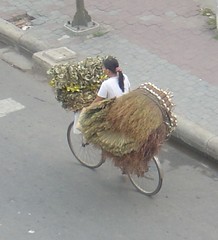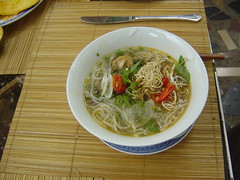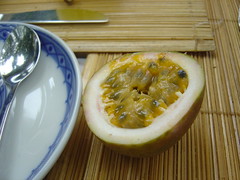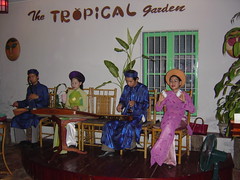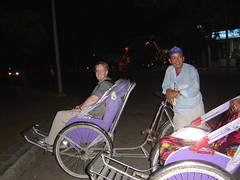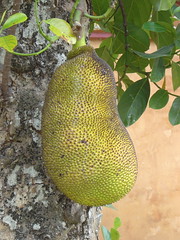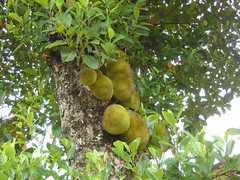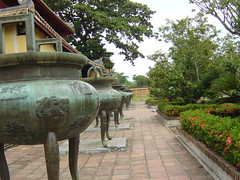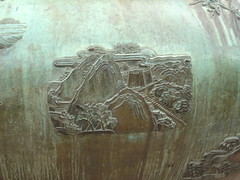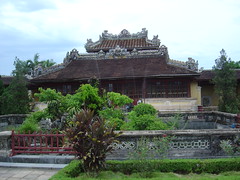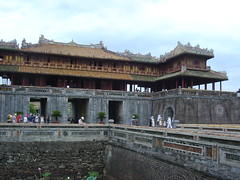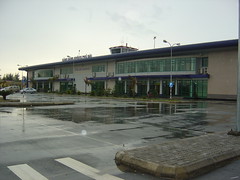As recently as five years ago, the sterotypical desctiption of major cities in Vietnam included a reference to streets choked with bicycles. As wages have risen since economic reforms, the scooter has replaced the bicycle in most areas.
Only in the more remote areas will you see bicycles still used as the primary means of transportation. Here, a young woman is using her bicycle as a delivery truck. A steady stream of similarly laden bicycles passed beneath our hotel window in Hue.
In Saigon or Hanoi, these would have been scooters laden down with twice as much. We saw scooters carrying anything you can imagine being balanced on the back of one: Chickens in coops, piglets in cages, construction rebar, huge stacks of 5 gallon water bottles, you name it. Unlike bicycles that still require human muscle for propulsion, the only limit to what can go on a scooter is imagination and balance.
Monday, September 26, 2005
Tuesday, September 20, 2005
Bun Bo Hue for Breakfast
Soup is an important breakfast food in Vietnam. The best known soup is called pho, which originated in the North, but has spread throughout the country with minor regional variations.
Another popular soup is bun bo hue which translates loosely as "beef soup from Hue". It's named after Hue in the sense that Buffalo chicken wings are named after the city of Buffalo. Like Buffalo chicken wings, bun bo hue is spicier than other similar dishes.
Bun bo hue is available in other regions and is often advertised alongside pho, but we wanted to try the real thing from Hue. Like all the hotels we stayed at, the Saigon Morin offered a full breakfast buffet, which had both pho and bun bo hue. We were there at the same time as a large group of tourist industry workers on an incentive trip, so the lines for pho and bun stayed much longer than when we were at places with a more Western mix of guests.
The fruit tray also offered a fruit we hadn't seen at the other buffets. This one is greenish on the outside with bright yellow juicy meat and a lot of seeds. We were stumped as to what it was until I e-mailed a link to the picture to the noodlepie guy who guessed that it was a passion fruit. Further web searching confirmed this.
Passion fruit juice was often available with breakfast along with papaya juice, mango juice, pineapple juice or lemon juice. Vietnamese lemon juice is not the concentrated tart cooking ingredient like in the US, but is a drink that is lighter and sweeter than American lemonade.
Fresh fruit was always available for breakfast. There was usually a choice of that could include pineapple, mango, lychees, rambuttans, grapefruit, or dragonfruit. The Saigon Morin was the only place that had fresh passion fruit as well.
Another popular soup is bun bo hue which translates loosely as "beef soup from Hue". It's named after Hue in the sense that Buffalo chicken wings are named after the city of Buffalo. Like Buffalo chicken wings, bun bo hue is spicier than other similar dishes.
Bun bo hue is available in other regions and is often advertised alongside pho, but we wanted to try the real thing from Hue. Like all the hotels we stayed at, the Saigon Morin offered a full breakfast buffet, which had both pho and bun bo hue. We were there at the same time as a large group of tourist industry workers on an incentive trip, so the lines for pho and bun stayed much longer than when we were at places with a more Western mix of guests.
The fruit tray also offered a fruit we hadn't seen at the other buffets. This one is greenish on the outside with bright yellow juicy meat and a lot of seeds. We were stumped as to what it was until I e-mailed a link to the picture to the noodlepie guy who guessed that it was a passion fruit. Further web searching confirmed this.
Passion fruit juice was often available with breakfast along with papaya juice, mango juice, pineapple juice or lemon juice. Vietnamese lemon juice is not the concentrated tart cooking ingredient like in the US, but is a drink that is lighter and sweeter than American lemonade.
Fresh fruit was always available for breakfast. There was usually a choice of that could include pineapple, mango, lychees, rambuttans, grapefruit, or dragonfruit. The Saigon Morin was the only place that had fresh passion fruit as well.
Saturday, September 17, 2005
Traditional Music In Hue
Hue is much more tourist oriented than Hanoi or Saigon. Several restaurants in the downtown area cater almost exclusively to tour groups. They have multi-entree fixed menus and feature musicians in native costume playing traditional music.
The musicians are quite good and play about a thirty minute set at a time. The restaurant was, like many in Vietnam, un-airconditioned and even after sunset quite hot despite large fans set up near every table. My family was about the only group there without a tour guide to help them with the menu.
The table next to us was a group of Australians on a guided tour. We would keep running into them at all the local attractions the following day.
The restaurant was less than half a mile from our hotel, but the heat tempted us into taking a group of cyclos parked in front of the hotel. Cyclos are the traditional Vietnamese form of transportation that consist of a seat attached to a tricycle that has two wheels in front and a driver in the back.
Scooters have all but eliminated cyclos in the bigger cities, but both tourist cyclos and everyday cyclos were still in use in Hue. The three of us cost some ridiculuously low price, probably about USD$2 total, to be ridden the five minutes down to the restaurant. Once there, the drivers agreed to wait until we were done with dinner and then drove us back for the same fare.
The musicians are quite good and play about a thirty minute set at a time. The restaurant was, like many in Vietnam, un-airconditioned and even after sunset quite hot despite large fans set up near every table. My family was about the only group there without a tour guide to help them with the menu.
The table next to us was a group of Australians on a guided tour. We would keep running into them at all the local attractions the following day.
The restaurant was less than half a mile from our hotel, but the heat tempted us into taking a group of cyclos parked in front of the hotel. Cyclos are the traditional Vietnamese form of transportation that consist of a seat attached to a tricycle that has two wheels in front and a driver in the back.
Scooters have all but eliminated cyclos in the bigger cities, but both tourist cyclos and everyday cyclos were still in use in Hue. The three of us cost some ridiculuously low price, probably about USD$2 total, to be ridden the five minutes down to the restaurant. Once there, the drivers agreed to wait until we were done with dinner and then drove us back for the same fare.
Wednesday, September 14, 2005
Royal Fruit
The jack fruit is one of the largest fruits in the world, and it grows throughout Vietnam and other tropical countries. We were familar with jack fruit because Vietnamese immigrants in the US frequently eat dried jack fruit chips as snacks. We had picked up some jack fruit chips in the Hanoi airport lounge, but hadn't seen real jack fruit until we got to Hue.
The jack fruit is typically about a foot tall and about a half foot in diameter, but can be much bigger. The trees are taller than citrus trees and have large broad leaves, but the fruit hang off branches very close to the trunk. The fruit also tend to grow in clusters like grapefruit.
The meat is in little pulpy pods and ripe fruit have a single seed in each pod. The pulp is softer than ripe banana and sweeter.
In Hue, unlike the rest of the country, the jack fruit was reserved for royalty and could only be grown on the grounds of the Imperial Palace. This restriction is still honored today in modern Hue.
For more than you could ever care to know about jackfruit see this article from Purdue University.
The jack fruit is typically about a foot tall and about a half foot in diameter, but can be much bigger. The trees are taller than citrus trees and have large broad leaves, but the fruit hang off branches very close to the trunk. The fruit also tend to grow in clusters like grapefruit.
The meat is in little pulpy pods and ripe fruit have a single seed in each pod. The pulp is softer than ripe banana and sweeter.
In Hue, unlike the rest of the country, the jack fruit was reserved for royalty and could only be grown on the grounds of the Imperial Palace. This restriction is still honored today in modern Hue.
For more than you could ever care to know about jackfruit see this article from Purdue University.
Tuesday, September 13, 2005
Dynastic Urns
Nine enormous bronze urns stand in front of the Hien Lam Cac temple in the Imperial Palace complex in Hue. Cast between 1835 and 1837 and weighing between 1500 and 2600 kilograms each, the urns are considered the pinnacle of Vietnamese bronze casting.
Each urn is a tribute to a previous ruler and has 17 decorative figures inscribed into the side. The largest urn weighs 2755 kg and is dedicated to Gia Long, the founder of the Nguyen dynasty. The figures illustrate various geographic, cultural, and historical aspects of life in nineteenth century Vietnam, including rivers, animals, flowers, and landscapes.
The Hien Lam Cac temple is also dedicated to the Nguyen dynasty rulers. Separate altars are set up for ten of the thirteen Nguyen emperors. The French refused to allow temples to be erected for the later leaders out of fear of creating symbols for nationalistic pride. Altars for these leaders were added in 1954.
Each urn is a tribute to a previous ruler and has 17 decorative figures inscribed into the side. The largest urn weighs 2755 kg and is dedicated to Gia Long, the founder of the Nguyen dynasty. The figures illustrate various geographic, cultural, and historical aspects of life in nineteenth century Vietnam, including rivers, animals, flowers, and landscapes.
The Hien Lam Cac temple is also dedicated to the Nguyen dynasty rulers. Separate altars are set up for ten of the thirteen Nguyen emperors. The French refused to allow temples to be erected for the later leaders out of fear of creating symbols for nationalistic pride. Altars for these leaders were added in 1954.
Wednesday, September 07, 2005
The Restoration of Hue
Hue lost its government function after the division of the country and the last emperor abdicated (Although there is apparently a misguided group somewhere trying to reinstall the dynasty. Good luck with that, guys.), and Ho Chi Minh moved the capital back to Hanoi. During the Tet offensive, North Vietnamese Army (NVA) forces occupied and held the Imperial Palace grounds for nearly a month. The fierce hand to hand combat and intense shelling destroyed most of the existing buildings.
One of the few buildings to survive was the Royal Reading Room. This building has very ornate styling but is structurally unsound and not open to the public. Carefully camouflaged buttresses hold the building up. One side of the building has a small lake and garden designed around feng shui principles.
The government is slowly restoring or rebuilding the rest of the grounds under auspices of UNESCO. The restored buildings are stunning in both beauty and size. A large diorama shows the entire complex before it was destroyed. The entire royal city was a large fortified enclave complete with multiple sets of moats. There were separate areas for the mandarins, the military, the emperor’s concubines, and different members of the royal family.
In the northwest corner of the complex, a large construction project is underway to restore the corner of the palace dedicated to the Emperor’s mother. The artist rendering on the construction fence bore no resemblance to the massive earthwork and construction going on within the fence. The final product will be gorgeous. Several temple areas and the main palace have already been completed.
The Tet Offensive was military victory for the US and South Vietnam, a propaganda watershed for North Vietnam, and an incalculable tragedy to the people of Hue and the country’s cultural heritage.
See this website for more information about the Imperial Palace in Hue as well as the surrounding area.
One of the few buildings to survive was the Royal Reading Room. This building has very ornate styling but is structurally unsound and not open to the public. Carefully camouflaged buttresses hold the building up. One side of the building has a small lake and garden designed around feng shui principles.
The government is slowly restoring or rebuilding the rest of the grounds under auspices of UNESCO. The restored buildings are stunning in both beauty and size. A large diorama shows the entire complex before it was destroyed. The entire royal city was a large fortified enclave complete with multiple sets of moats. There were separate areas for the mandarins, the military, the emperor’s concubines, and different members of the royal family.
In the northwest corner of the complex, a large construction project is underway to restore the corner of the palace dedicated to the Emperor’s mother. The artist rendering on the construction fence bore no resemblance to the massive earthwork and construction going on within the fence. The final product will be gorgeous. Several temple areas and the main palace have already been completed.
The Tet Offensive was military victory for the US and South Vietnam, a propaganda watershed for North Vietnam, and an incalculable tragedy to the people of Hue and the country’s cultural heritage.
See this website for more information about the Imperial Palace in Hue as well as the surrounding area.
Sunday, September 04, 2005
Forbidden City
The Nguyen Dynasty moved the capital of Vietnam from Hanoi to Hue, in the center of the country, to consolidate the north and the south. When they did, they built an enormous imperial palace modeled after the Chinese Forbidden City. The massive front gates for the complex are pictured here. Each gate was for a specific rank of person and only the emperor could use the large center gate.
The Nguyens only ruled Vietnam for less than 150 years beginning in the early 1800's, but their dynasty had enough palace intrigue and back-stabbing to rival any royal family westerners are familar with.
Our guide for the two days we were in Hue kept explaining the roles of the thirteen different emperors, but it was a lost cause for me to try to keep them straight. What makes it very confusing is that each emperor has a family name, a dynasty name, a temple name, and a posthumous name. For example, the founder of the dynasty had the family name of Nguyễn Phúc Ánh, but took the name of Gia Long when he became emperor. After his death, he was known as Cao Hoàng Đế and he is buried at the Thế Tổ Temple.
The Nguyens were a colorful lot. One emperor had over 60 children and another, as our guide delicately put it, preferred men to women. One emperor only lasted three days because the mandarins discovered he had forged the previous emperor's will. And that's just the juicy stuff I remember. Some future James Clavell has a rich tapestry to exploit here.
The Nguyens only ruled Vietnam for less than 150 years beginning in the early 1800's, but their dynasty had enough palace intrigue and back-stabbing to rival any royal family westerners are familar with.
Our guide for the two days we were in Hue kept explaining the roles of the thirteen different emperors, but it was a lost cause for me to try to keep them straight. What makes it very confusing is that each emperor has a family name, a dynasty name, a temple name, and a posthumous name. For example, the founder of the dynasty had the family name of Nguyễn Phúc Ánh, but took the name of Gia Long when he became emperor. After his death, he was known as Cao Hoàng Đế and he is buried at the Thế Tổ Temple.
The Nguyens were a colorful lot. One emperor had over 60 children and another, as our guide delicately put it, preferred men to women. One emperor only lasted three days because the mandarins discovered he had forged the previous emperor's will. And that's just the juicy stuff I remember. Some future James Clavell has a rich tapestry to exploit here.
Thursday, September 01, 2005
Flying The Friendly Skies Of Vietnam
While traveling in Vietnam, I wanted to see as much of the country as I could. A train trip sounded nice until I did the research. The fastest train between Saigon and Hanoi takes over thirty hours. A direct flight by plane is just over two hours. The train idea was nixed. Airfare within Vietnam is also reasonably priced considering the government run airline has a virtual monopoly. One hundred dollars get you one way from Saigon to Hanoi and sixty bucks is the rate for Hanoi or Saigon to Hue.
Nationalized airlines, especially those run by third world countries, have a lot of national image at stake that gets projected by their air carriers. The domestic jets we flew were new and clean and attractively decorated. All the inflight literature bragged about Vietnam Airlines brand new Boeing 777’s on selected international routes. We had seen one of these ready for delivery on our factory tour of Boeing in Washington state a year earlier.
As part of that nation image, the airlines do not suffer the politically correct employment practices that don’t allow for appearance to be a hiring criteria. Male and female flight attendants on Vietnam Airlines flights (and JAL for that matter) are casting call perfect examples of health, youth, and courteousness.
National pride also immunizes them from the cost cutting rampage that has destroyed service in the domestic United States. Our two-hour morning flight to Hanoi included meal service, something that has become extinct on US domestic flights of that length. A chice of fish porridge or pork sticky rice was offered with choice of juice. The shorter flights between Hanoi and Hue and Hue to Saigon had banh mi sandwiches with full beverage service. We have been on New York to Baltimore hops where 4-ounce water bottles were dispensed sparingly.
From Narita as we progressed to Saigon, Hanoi, and finally Hue, we kept reaching progressively smaller airports reaching the practical limit in Hue. The terminal there was a two story rectangular building that could have been built anytime in the past fifty years. All the check-in and security was downstairs and the upstairs was one large cavernous waiting room with some vending machines and gift shop counters selling the ubiquitous silk blouses, ties, and other knick-knacks. We picked up some cute little silk purses. Two flights worth of departing passengers filled the place to capacity.
In Vietnam we also became accustomed to the forgotten practice of boarding from a ramp on the tarmac. Ramps would be placed at both ends of the plane and boarding would be a free-for-all of shoving up the narrow staircases. Boarding by seat row is not a concept that has caught on yet. It also seemed a little ridiculous to take a shuttle bus for the 100 yards from the plane to the terminal. All in all, air travel in Vietnam is a comfortable and relatively inexpensive way to traverse the long narrow country.
Nationalized airlines, especially those run by third world countries, have a lot of national image at stake that gets projected by their air carriers. The domestic jets we flew were new and clean and attractively decorated. All the inflight literature bragged about Vietnam Airlines brand new Boeing 777’s on selected international routes. We had seen one of these ready for delivery on our factory tour of Boeing in Washington state a year earlier.
As part of that nation image, the airlines do not suffer the politically correct employment practices that don’t allow for appearance to be a hiring criteria. Male and female flight attendants on Vietnam Airlines flights (and JAL for that matter) are casting call perfect examples of health, youth, and courteousness.
National pride also immunizes them from the cost cutting rampage that has destroyed service in the domestic United States. Our two-hour morning flight to Hanoi included meal service, something that has become extinct on US domestic flights of that length. A chice of fish porridge or pork sticky rice was offered with choice of juice. The shorter flights between Hanoi and Hue and Hue to Saigon had banh mi sandwiches with full beverage service. We have been on New York to Baltimore hops where 4-ounce water bottles were dispensed sparingly.
From Narita as we progressed to Saigon, Hanoi, and finally Hue, we kept reaching progressively smaller airports reaching the practical limit in Hue. The terminal there was a two story rectangular building that could have been built anytime in the past fifty years. All the check-in and security was downstairs and the upstairs was one large cavernous waiting room with some vending machines and gift shop counters selling the ubiquitous silk blouses, ties, and other knick-knacks. We picked up some cute little silk purses. Two flights worth of departing passengers filled the place to capacity.
In Vietnam we also became accustomed to the forgotten practice of boarding from a ramp on the tarmac. Ramps would be placed at both ends of the plane and boarding would be a free-for-all of shoving up the narrow staircases. Boarding by seat row is not a concept that has caught on yet. It also seemed a little ridiculous to take a shuttle bus for the 100 yards from the plane to the terminal. All in all, air travel in Vietnam is a comfortable and relatively inexpensive way to traverse the long narrow country.
Subscribe to:
Posts (Atom)
